Bell XV-3 experimental tiltrotor
The experimental Bell XV-3 had a large fuselage for 4 passengers, fixed wings with a span of 9,54 meters and a Pratt & Whitney R-985 engine, which developed a maximum power of 450 hp. The rotor-propeller, which was located on the console of each wing, was transferred to the required position using electric motors: upward for vertical flight, forward for horizontal flight.
In order to obtain an aircraft that could combine the features of the aircraft and the helicopter, many attempts were made to create a variety of rotary-winged vehicles, including turning screws, which in the west were called convertiplane, and in our country - a helicopter-plane. These aircraft were equipped with large-diameter rotary screws with hinged blades and a small load on the swept area, like in helicopters, which made it possible for such machines to make a vertical take-off with a relatively small power of the engine mounted on them.
Bell XV-3
For many years, Bell conducted a large amount of research and experimental work in the field of creating convertoplanes, the work in this direction was led by designers Arthur Young and Bertrand Kelly, and later they were joined by Robert Lichten. At the competition held by the US Army in 1950 for the best design of an aircraft designed for front-line reconnaissance and rescue services, Bell presented a design of a tiltrotor with turning screws. In total, the commission reviewed 17 of various projects, of which the entire 3 project of the rotary-winged aircraft, including the Bell project, was selected. According to the results of the competition held in 1951, the United States Air Force signed a contract with the company for the construction of two experimental convertoplanes for the next flight tests of the vehicles.
The construction of the first convertible from Bell, which was originally designated Bell XH-33, and later Bell XV-3, was delayed, the work was completed only at the beginning of 1955, and the first official demonstration of the novelty took place in February of the same year. 10 August 11, the first vertical take-off and hovering flights were made, and then the transitions to horizontal flight, when the inclination of the propellers reached 1955 degrees (test pilot Floyd Carlson). In subsequent tests of converters that passed 15 on October 25 of the year in the air at an altitude of 1956 meters when the screws were inclined at 60 degrees, the unit lost controllability due to mechanical instability and fell, while Bell XV-20 was destroyed and test pilot Dick Stensbury as a result of the fall was seriously injured.
Also, the tiltrotor was tested on a special stand, on which the full transition to the flight mode “in an airplane” was performed. When moving from helicopter flight mode to aircraft, the propellers inclined by 90 degrees using a worm gear from electric motors. The transition process usually took just 15-20 seconds. At the same time, the Bell XV-3 tiltrotor was able to continue flying at any intermediate position of the screws during the transition. In total, this tiltrotor performed more than 250 test flights and 110 complete transitions between flight modes, flying during this time about 450 hours. During these flights, the maximum speed of 290 km / h was reached, as well as the altitude of 3660 meters. Tests of the convertoplan continued in the 1965 year, but already in a wind tunnel. These tests were stopped due to the separation of the gondola with a screw and the damage received by Bell XV-3.
The Air Force and the US Army had very high hopes for the development of this type of aircraft, believing that convertible gliders were best suited for conducting reconnaissance, communications and rescue operations. Bell has created a number of projects of both military and civilian models of such rotary-wing aircraft. On a number of them it was planned to install two gas turbine engines located in gondolas under the wing, while the maximum speed was to be about 400 km / h.
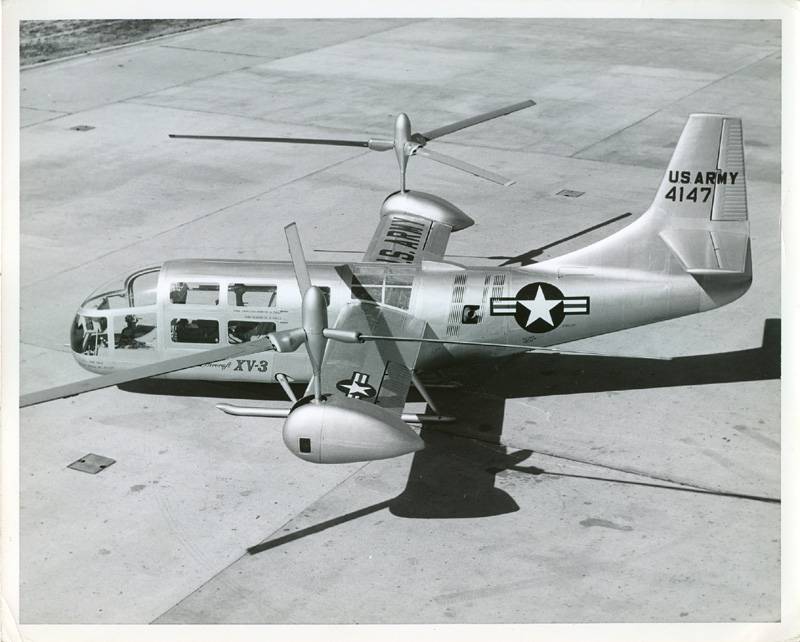
Externally, the experimental tilt-rotor Bell XV-3 is a single-engine monoplane with two rotary three-bladed propellers, as well as a skid chassis of a very simple design, the chassis gauge was 2,8 meters. In this case, the aircraft fuselage was distinguished by good aerodynamic forms. A cabin with a large glass area was located in its nose. In this cockpit were a pilot, a co-pilot or an observer, as well as two passengers, instead of them it was possible to place a wounded man on a stretcher along with an orderly. The wing of the convertoplane was straight and had a relatively small area, as it was designed to create lift only at cruising speed. At the ends of the wing were small gondolas with turn screws. The wing cover could be removed by technical service representatives to access transmission elements. The wing also had retractable flaps and ailerons. The tail of the tail was the same as that of conventional aircraft - with a rudder, with a large vertical tail area, on the keel there was a stabilizer with an 4 span of a meter with elevators.
Because of its design, the Bell XV-3 has a number of unique features in operation. For example, the cross transmission, which was typical for multi-engine aircraft, was absent. In the event of a power plant failure, the Bell XV-3 screws were automatically brought to the vertical position, as a result of which the tiltrotor could be reduced to autorotation as an ordinary helicopter or an ordinary gyroplane. At the same time, propellers bent forward to create thrust, however, during horizontal flight, part of the lifting force was nevertheless created by the wing of the vehicle.
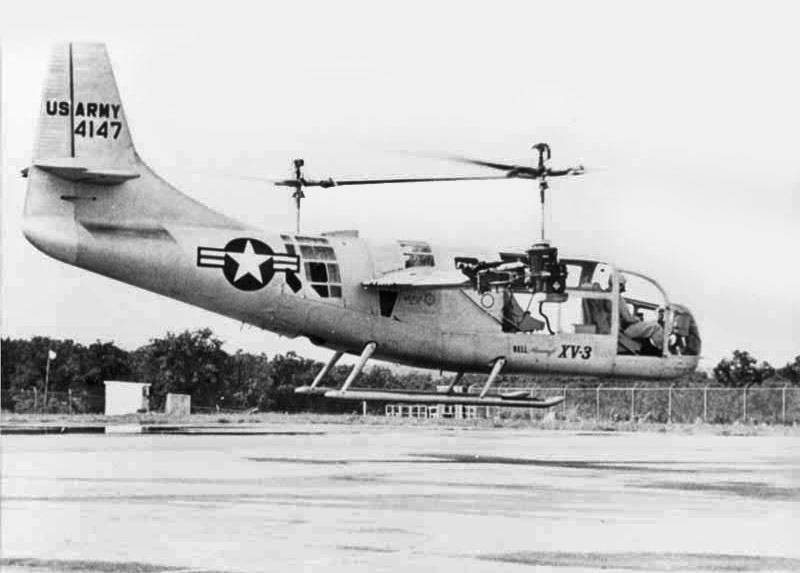
As the power plant on the experimental tiltrotor Bell XV-3 was used aviation radial piston air-cooled engine from Pratt & Whitney. It was the R-985-AN-1 and the engine had a maximum power of 450 hp. at 2300 rpm at an altitude of 450 meters and during takeoff. The engine was installed in the central part of the fuselage. Due to the insufficient power of the power plant, the maximum speed was limited to 280 km / h, although the tiltrotor showed a greater value during tests. Achieving higher speed was possible by replacing the engine with a more powerful one. In particular, there were plans to install a twin-shaft GTE Lycoming T-53, which developed a power of 825 hp.
After the completion of the Bell XV-3 tests, the idea of a convertiplane in the USA was not abandoned. After him, a new model was born. The new aircraft was equipped with already turning engines. He received the designation Bell XV-15, he made his first flight in May 1977. And 19 March 1989 of the year, the Bell V-22 Osprey tiltrotor flew into the sky, which has been in service since 2005. He serves in the Marine Corps and the Command of Special Forces of the US Air Force. According to the 2016 year, more than 300 devices of this type were built in total, the delivery of these convertible planes to the US armed forces is still continuing.
Flight technical characteristics of the XV-3 convertoplane:
Overall dimensions: length - 9,2 m, height - 4 m, wing span - 9,5 m, diameter of the turning screws - 7,6 m.
Empty weight - 1907 kg.
Take-off weight - 2218 kg.
The power plant is a Pratt Whitney R-985-AN-1 HPD HP 450.
Maximum speed - 290 km / h.
Cruising speed - 269 km / h.
Practical range - 411 km.
Practical ceiling - 4600 m.
Rate of climb - 6,3 m / s.
Crew - 1 man.
Information sources:
http://www.dogswar.ru/oryjeinaia-ekzotika/aviaciia/4337-eksperimentalnyi-sam.html
http://www.k2x2.info/transport_i_aviacija/amerikanskie_samolety_vertikalnogo_vzleta/p2.php
http://www.popmech.ru/technologies/14617-samolet-vertolet-effektnyy-eksperiment/#full
Open source materials
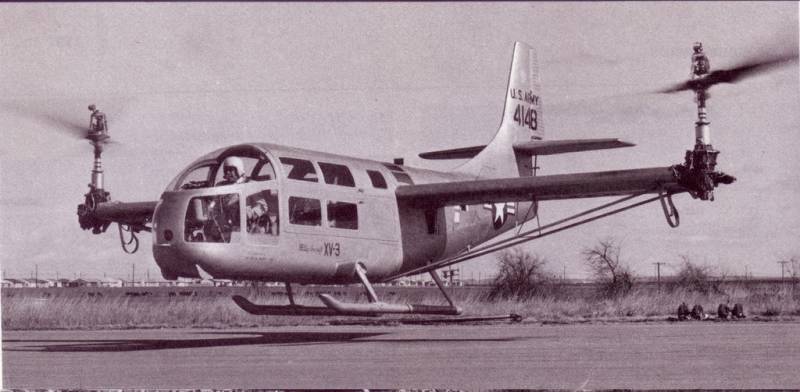
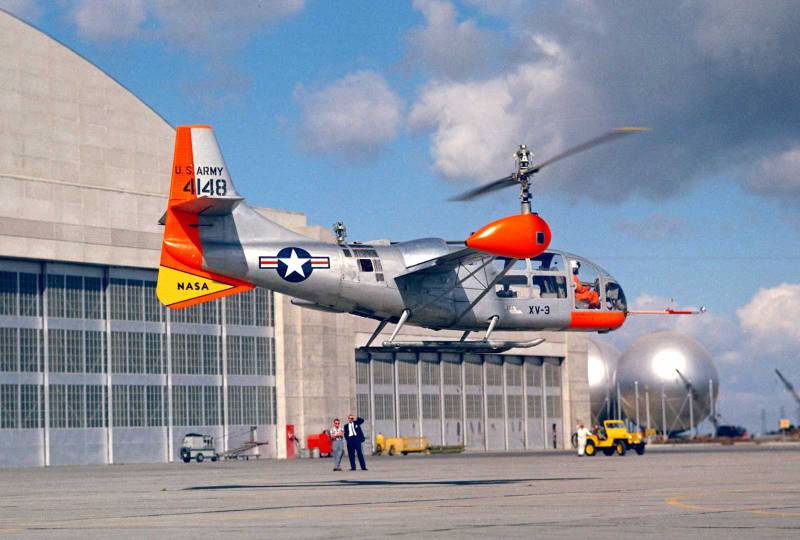
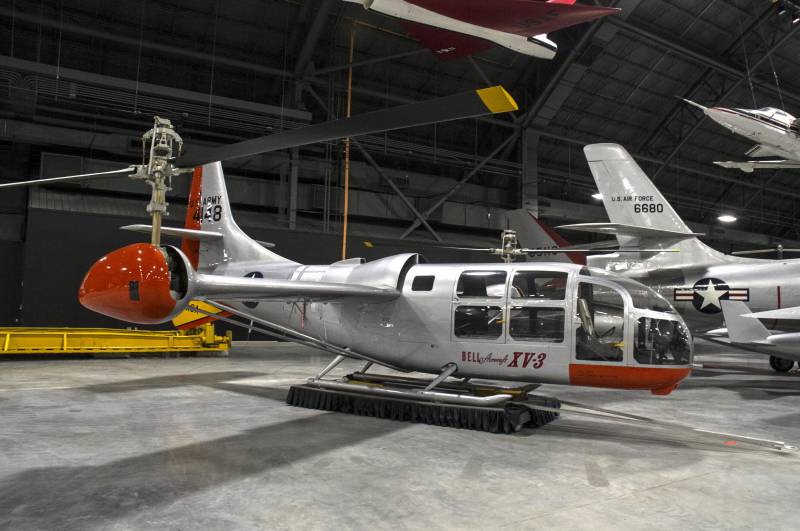
Information